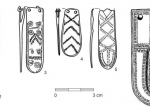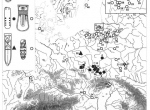Tongue-shaped strap-end
Tongue-shaped strap-end, a variant of metal strap mounts typical mostly for the late Roman Period (ca. 300/310-375 AD) and early →Migration Period (ca. 375-480 AD). Appear mainly in the context of dress accessories, as strap-ends; usually made of bronze, in the form of a rectangular plaque, rounded at one end, the other end straight and usually split, provided with between 1 and 3 rivets for attachment. Some specimens are decorated with simple engraved designs, others with more elaborate stamped compositions reminiscent of the →Sösdala-Untersiebenbrunn Style (fig. 1.)
The largest number of strap-ends of this form is recorded in the West Balt culture →Balts environment, much more rarely – on the territory of →Przeworsk Culture (mainly on its southern margin) and →Wielbark Culture , sporadically, in other areas of →Barbaricum (map 1.).
Similar mounts, of slightly different proportions and much more diverse in terms of their execution and material, appear a little earlier, during 3rd century AD, in the northern Pontus and in the Great Hungarian Plain, in archaeological cultures linked with the nomad Sarmatian tribes. In this environment they are elements of belt sets, horse harness or boot fasteners.
MP
Literature: A. Bitner-Wróblewska, From Samland to Rogaland. East-West connections in the Baltic basin during the Early Migration Period, Warszawa 2001; M.-J. Brather, Zwei bronzene Riemenzungen der Völkerwanderungszeit aus dem östlichen Brandenbrug, Jahrbuch für Bodendenkmalpflege in Mecklenburg-Vorpommern, vol. 51, 2004, p. 375-396; M. Mączyńska, Pommern in der Völkerwanderungszeit – 20 Jahre nach dem Aufsatz von Kazimierz Godłowski, [in:] J. Tejral (ed), Barbaren im Wandel. Beiträge zur Kultur- und Identitätsumbildung in der Völkerwanderungszeit, Spisy Archeologického Ústavu AV ČR Brno, Brno 2007, p. 147-171; R. Madyda-Legutko, Studia nad zróżnicowaniem metalowych części pasów w kulturze przeworskiej. Okucia końca pasa, Kraków 2011.




